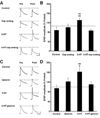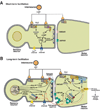Postsynaptic regulation of long-term facilitation in Aplysia
- PMID: 18571411
- PMCID: PMC2711037
- DOI: 10.1016/j.cub.2008.05.038
Postsynaptic regulation of long-term facilitation in Aplysia
Abstract
Repeated exposure to serotonin (5-HT), an endogenous neurotransmitter that mediates behavioral sensitization in Aplysia[1-3], induces long-term facilitation (LTF) of the Aplysia sensorimotor synapse [4]. LTF, a prominent form of invertebrate synaptic plasticity, is believed to play a major role in long-term learning in Aplysia[5]. Until now, LTF has been thought to be due predominantly to cellular processes activated by 5-HT within the presynaptic sensory neuron [6]. Recent work indicates that LTF depends on the increased expression and release of a sensory neuron-specific neuropeptide, sensorin [7]. Sensorin released during LTF appears to bind to autoreceptors on the sensory neuron, thereby activating critical presynaptic signals, including mitogen-activated protein kinase (MAPK) [8, 9]. Here, we show that LTF depends on elevated postsynaptic Ca2+ and postsynaptic protein synthesis. Furthermore, we find that the increased expression of presynaptic sensorin resulting from 5-HT stimulation requires elevation of postsynaptic intracellular Ca2+. Our results represent perhaps the strongest evidence to date that the increased expression of a specific presynaptic neuropeptide during LTF is regulated by retrograde signals.
Figures




References
-
- Brunelli M, Castellucci V, Kandel ER. Synaptic facilitation and behavioral sensitization in Aplysia: possible role of serotonin and cyclic AMP. Science. 1976;194:1178–1181. - PubMed
-
- Montarolo PG, Goelet P, Castellucci VF, Morgan J, Kandel ER, Schacher S. A critical period for macromolecular synthesis in long-term heterosynaptic facilitation in Aplysia. Science. 1986;234:1249–1254. - PubMed
Publication types
MeSH terms
Substances
Grants and funding
LinkOut - more resources
Full Text Sources
Research Materials
Miscellaneous

